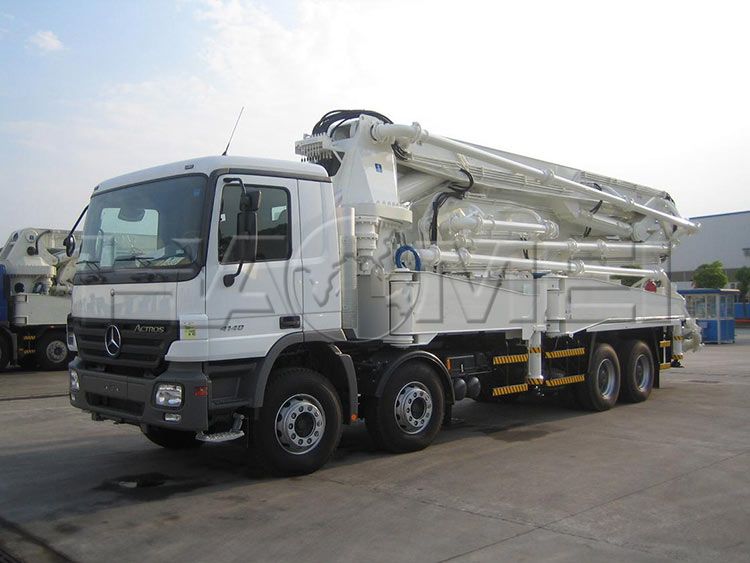What Are Types of The Concrete Lifting Pump
Posted On: 15/10/2025 | Posted by: Haomei Concrete Pumps
In modern construction, concrete delivery efficiency directly impacts project progress and quality. The concrete lifting pump has long replaced traditional manual pouring with its efficient and stable delivery capabilities, becoming essential equipment for projects such as bridges, high-rise buildings, and factories.

Trailer Concrete Pumps
Trailer concrete pumps are a relatively new type of concrete delivery equipment. Their key feature is that they lack a built-in travel mechanism and require transport via a trailer or crane. During operation, they rely on a concrete placing boom for concrete distribution.
Core Advantages:
1. Strong delivery capacity
The power system and delivery pipeline design of trailer concrete pumps emphasize high pressure and long distance delivery. They can deliver concrete horizontally from 100 to 300 meters and vertically to heights exceeding 150 meters (some high-pressure models can exceed 200 meters). They are particularly suitable for applications requiring deep and long-distance delivery, such as super-high-rise building foundations and bridges.
2. Wide adaptability
Concrete pump trailers are compatible with various concrete grades (including high-strength concrete C60 and above) and have a high tolerance for aggregate size (typically a maximum aggregate size of 30-50mm). They can operate stably even on construction sites with fluctuating sand and gravel quality, reducing the risk of pipe blockage.
3. Cost controllable
Compared to other types of pumps, concrete line pumps have lower purchase costs and low replacement costs for wearing parts (such as the delivery cylinder and eyepiece plates). They are suitable for long-term, fixed-position operation on large projects (such as industrial park construction and hydropower stations), reducing unit operating costs.
Concrete Boom Pumps
Concrete boom pumps integrate a pumping system and a folding boom onto a vehicle chassis. Their most notable features are their built-in travel function and self-distribution capability. During operation, the boom can be deployed to deliver concrete directly to the pouring site, eliminating the need for a separate concrete placing boom.
Core Advantages
1. Flexible mobility and high transfer efficiency
Leveraging a vehicle chassis (commonly available in 6×4 and 8×4 configurations), the machine can be flexibly moved within a construction site or between projects. Arriving on site and commencing operations takes just 15-30 minutes, making it ideal for distributed, multi-location, short-term projects such as residential developments and road repairs.
2. Easy operation
The boom is hydraulically controlled, enabling 360° rotation and spreading of concrete, with a maximum spreading radius of 60 meters (for large pump trucks). A single operator can complete the entire process of "moving, positioning, and delivering" compared to a trailer-mounted concrete pump, reducing labor costs by 2-3 fewer operators.
3. High casting precision
The boom tip precisely aligns with the pouring point (e.g., wall and column formwork), eliminating losses caused by secondary handling after concrete is placed. This makes it particularly suitable for applications requiring high pouring precision, such as prefabricated buildings and special-shaped components.
Truck-mounted Concrete Pumps
A truck-mounted concrete pump (also known as a "boomless truck-mounted pump") is a compromise between a trailer pump and a concrete boom pump. It retains the high-pressure delivery capabilities of a trailer pump while integrating the pumping system onto a small vehicle chassis (such as a light truck), solving the difficulty of transporting a trailer pump. However, it lacks the folding boom of a concrete pump truck and still requires a concrete placing boom.
Core advantages:
1. Balance of maneuverability and delivery capacity
Compared to trailer pumps, truck-mounted concrete pumps do not require crane transport and can be independently driven short distances within the construction site. Compared to concrete boom pumps, they offer superior delivery head (up to 80-120 meters vertically) and displacement (30-50 cubic meters per hour), and their purchase cost is 30%-50% lower than new pump trucks for sale.
2. Strong site adaptability
The vehicle's width is typically less than 2.3 meters, making it suitable for narrow construction sites such as urban village redevelopment and old factory renovations. Larger pump trucks (with booms over 37 meters long) often struggle to access such sites due to their wide bodies and large turning radius.
3. Low operation and maintenance costs
The vehicle's wear parts are compatible with those of trailer pumps, making procurement and replacement easier. Furthermore, the vehicle's chassis repair technology is mature, eliminating the need for specialized manufacturers. Small and medium-sized construction teams can arrange for repairs themselves, reducing downtime.
Original source: https://www.concrete-pump-cn.com/a/what-are-types-of-the-concrete-lifting-pump.html
Tags: concrete boom pump,
Previous: Will You Choose Concrete Pump Tow Behind
Next: Should You Choose A Concrete Boom Machine


 feedom@haomei-machinery.com
feedom@haomei-machinery.com